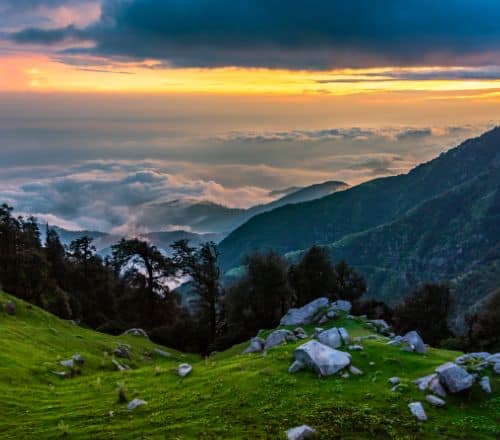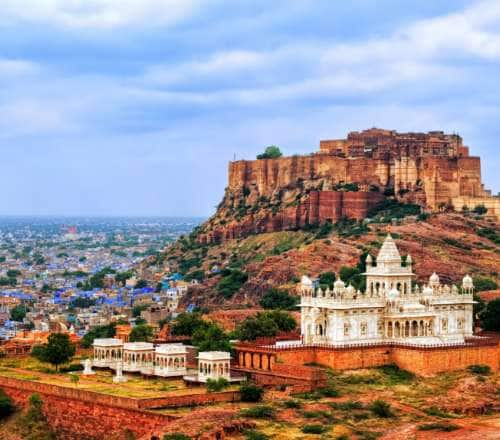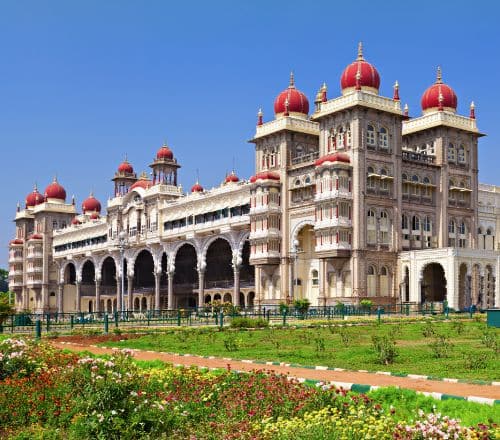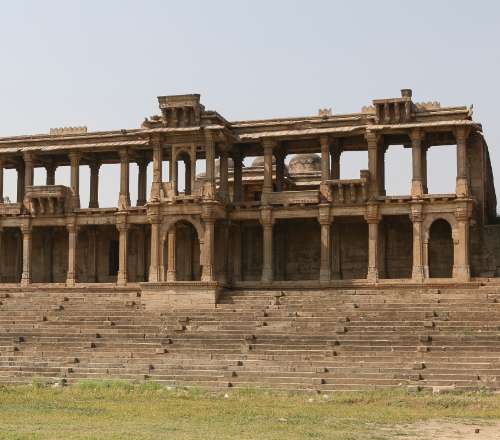Stay logged in to proceed with bookings, orders and offers.
On changing the terminal, you will loose items in your cart. Are you sure you want to change your terminal?
The unique temple festival of Thrissur Pooram is nothing short of a public spectacle, with caparisoned elephants, music recitals, and stunning fireworks.
The topic came up during our lunch break. While having food, one of my colleagues at the table spoke about Thrissur Pooram, which is one of the biggest temple festivals in India. The festival is celebrated in April-May, which is known as medam in Malayalam, in Thekkinkadu Maidanam in Thrissur. The word Pooram means "festival" in Malayalam; hence, the name of the festival.
With the festival only a couple of months away, the traveller in me felt a spark of inspiration. Two months later, I was in Thrissur, witnessing the spectacle that is Thrissur Pooram along with my colleagues. What started as a lunchtime conversation turned into a full-fledged trip!
Thrissur Pooram is a grand public celebration. Expect to see elephants decorated with glittering ornaments sashaying down the road, skies lit with brilliant fireworks, and the beats from the chenda melam filling the air. The chenda is a cylindrical percussion instrument used in various Hindu temple festivals and rituals, primarily in Kerala and Tamil Nadu. It is an integral part of all major celebrations in Kerala.
This article is an eyewitness guide to my experience at Thrissur Pooram along with some interesting facts so that you, too, can plan a similar trip.
Read More
Read Less
As my colleague had rightly mentioned, Thrissur Pooram is indeed among the biggest temple gatherings in Asia. When I was in Thrissur, the first thought that came to me was that my colleague was not exaggerating about the scale of Thrissur Pooram.
The origins of Thrissur Pooram can be traced back to Arattupuzha Pooram, which was the largest temple festival in Kerala in the 17th century. Arattupuzha Pooram was held at the Arattupuzha Temple in the village of Arattupuzha, in Thrissur. Temples around the city regularly participated in this festival. However, in 1798, some temples in Thrissur reported late to Arattupuzha Pooram due to heavy rains and were denied entry.
The dejected temple authorities complained to Sakthan Thampuran, the ruler of the erstwhile Kingdom of Kochi. Sakthan Thampuran invited these temples to bring their deities and pay respects to Lord Vadakkunnathan – a form of Lord Shiva – who is the presiding deity of the Vadakkunnathan Temple, in Thrissur.
Sakthan Thampuran further divided these temples into two categories based on their geographical location. These two groups of temples competed in various events during Thrissur Pooram every year. Soon, it became a major temple festival in Thrissur.
Thrissur Pooram is a seven-day festival that is held at the Vadakkunnathan Temple and the adjoining Thekkinadu ground in Thrissur. Nothing beats the experience of partaking in the temple festivities over the seven-day period; however, my colleagues and I were able to attend the festival only for two days because we couldn't take those many days off. But we ensured that we were present on the two most important days of the festival.
We were a group of five. We booked an overnight journey aboard a train to Thrissur from Trivandrum. We boarded the train on a Friday night and reached Thrissur by Saturday morning. You can also take a bus from Trivandrum to reach Thrissur.
Upon arriving in Thrissur, we had lunch at a restaurant near the railway station. Thereafter, we hired a couple of auto rickshaws and checked into our homestay. Luckily, this homestay wasn't located too far from the Vadakkunnathan Temple, which is the venue of the festivities. We decided to take a nap to decompress before heading out to see the celebrations.
Travel tip: If you plan to visit Thrissur during Thrissur Pooram, be sure to book your accommodation at least a couple of months in advance. The rates for accommodation experience a steep hike as the festival nears. The availability of accommodation also significantly reduces due to high demand.
It was our first trip together and we were excited to experience Thrissur Pooram in a mundu. In case you're unaware, mundu is a traditional dhoti that is worn around the waist in Kerala. Mundu is worn during major festivals and celebrations in Kerala. During Thrissur Pooram, mundu is the unofficial attire for men. For women, it is sarees.
This being my first-ever experience wearing a mundu, I struggled to wear it the right way. However, my colleagues, who were from Kerala, helped me out. It's a good idea to wear a belt over the mundu to prevent it from slipping down your waist. A little precaution goes a long way in keeping it secure!
With the mundu taken care of, we hired an autorickshaw to reach Vadakkunnathan Temple. As we approached the temple, we heard loud cheering. The entire town seemed to vibrate with the thunderous cheering. At this point, I can say we had no clue about what lay ahead of us. We felt as though we'd arrived at a crowded stadium to watch a cricket match!
The autorickshaw stopped a few metres away from the temple. The entire complex was barricaded and security was tight. We covered the remaining distance on foot as we walked towards the temple. It was noon and the weather was scorching hot. We bought a few water bottles to stay hydrated. Soon, we reached the temple and let me tell you, it didn't seem like we were entering a temple. A huge crowd had gathered in the temple complex; it seemed like we were at a music concert!
As expected, the majority of the visitors were locals from Kerala along with a few tourists, including international tourists. Most of the men and women were dressed in mundu and sarees, respectively.
The loudest cheer of the day came when an elephant pushed open the main door of the temple and made its way to the crowd. The elephant was beautifully adorned with various ornaments and decorations. It carried the temple deity on its back.
A big group of local artists had assembled to play an orchestra of various percussion instruments, led by the chenda. This event is known as Ilanjithara Melam. It was a well-executed orchestra, with every instrument adding to the overall rhythm and feel of the music. You could easily tell they were professional artists who had been performing for years.
The entire crowd was vibing to the music, shaking their heads, and moving their hands to the beats like how you see in a concert. Soon, my colleagues and I joined in the action. The performance went on for a few hours.
By the end of the performance, we were rather dehydrated as we had been standing in the sun for hours. If you plan to attend the festival, ensure that you always have a bottle of water at hand and keep yourself hydrated. After a few hours, we left to have lunch at a nearby restaurant. All of us were tired and in desperate need of a break. However, the meal re-energised us and we headed back to the temple complex in the evening.
We saw around 15 elephants standing in a line on two opposite sides of the crowds. There were two to three people atop each of the elephants, holding brightly coloured umbrellas as they put on a show. The percussion artists played their beats in the background, adding to the routine as the crowd vibed to it. This event is known as Kudamattam where two groups of temples compete against each other by displaying various umbrellas atop the elephants.
By sunset, the weather had become rather pleasant. After watching the Kudamattam ritual, we returned to the homestay and had dinner at a restaurant nearby. After a long day outdoors, we bathed and relaxed in the homestay. At midnight, we went to the Swaraj Round, a 2-km-long circular road next to the temple.
Swaraj Round was the venue for the penultimate event wrapping up the festivities. This event is known as Vedikkettu or fireworks. In this event, two temple groups compete against each other by displaying an array of fireworks. By the time we arrived, a huge crowd had gathered at Swaraj Round and we found ourselves jostling for space. All mobile phones were out as people tried to capture the extravagant displays in the sky. The show lasted a few hours – it was the longest display of fireworks I'd ever seen. By the end of it, my ears felt numb owing to the thunderous noise of the fireworks!
After the event, we returned to our homestay and woke up late the next morning. After breakfast, we headed to Thrissur Railway Station to board our train back to Trivandrum, reminiscing about our exhausting yet exhilarating time at Thrissur Pooram.





The Adani One expressly disclaims all liability, direct and indirect, in respect to actions taken or not taken based on any or all the contents of this Blog. The Blog is an opinion of the contributor based on the collation of data from various sources and is provided only for information purpose. Adani One does not canvass, advertise, solicit, invite or induct for any product, merchandise, information, brand or any other materials mentioned in the Blog, nor does it obtain any monetary benefit from the same. Reader is advised to read and apply his/her intellect and discretion in this regard. Any Intellectual Property mentioned in this blog belongs to the rightful owner. We do not intent to claim any interest over the same.